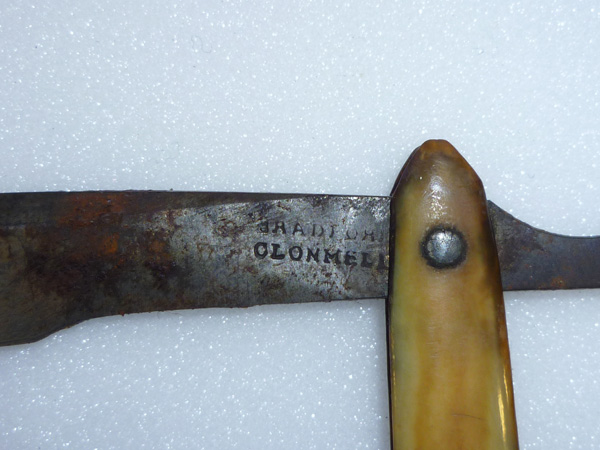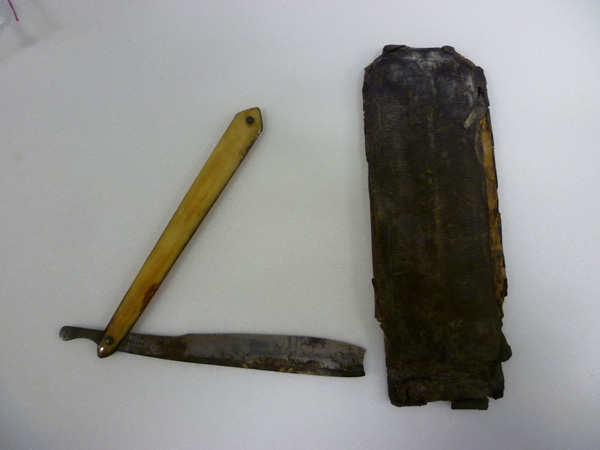Donated 1958
Two Razors and Case
A pair of identical cut throat razors with bone handles, made by the cutler and razor maker Joseph Bradford of Clonmel. The razors are reported to have been the possession of Hugh Hamill, who was involved in the 1798 Rebellion.
By Joanne Hamilton
The razors are made of hollow-ground steel blades hinged on bone hafts, into which the blades fold. Each blade is 13.6 cm in length and 1.7 cm in width. The upper end of the blade is concave and is hinged by a rivet, passing through the bone plates about 2.3 cm from the tapered end.
The bone plates have become discoloured with age in most parts, they measure 13.6 cm in length. At the proximal end they are 1.5 cm wide and cumulate in a triangular point, where a metal rivet holds them together. At the opposite end the plates taper to a width of 8 mm. A second metal rivet hinges the blade at this point and the blade curves out beyond the bone plates some 2.0 cm.Near the junction where the blade is riveted to the bone, both blades have been engraved with the stamp of their manufacturer, Bradford Clonmell. Joseph Bradford was a well-established cutler and razor maker in Clonmel, he is noted in the 1907 History of Clonmel as producing cutlery and razors of a “high character” during the 1800s.

Fig. 2: Detail of hinge and stamp of the maker, Bradford Clonmell
The accompanying case is of red leather lined with several layers of paper on the interior. It opens at one end where it can be closed by a tongued flap.

Fig. 3: Open razor and leather case
Who owned the razors?
The razors were donated to the National Museum in 1958 by the great grandson of the original owner, Mr Hugh Hamill. Mr Hamill was an under-steward on the Shane Castle Estate in Co. Antrim and it is believed that he was involved in the 1798 Rebellion.
The Shane Castle Estate lies on the shores of Lough Neagh, between the towns of Antrim and Randalstown, Co. Antrim. The original castle took its name from Shane McBrian O'Neill. By 1798 the castle and estate were held by Viscount John O’Neill, who was generally considered to be a good landlord and was well respected in the area.
Following the outbreak of the rebellion, O’Neill returned to Co. Antrim from Dublin amid reports of the insurrection spreading to Antrim. On his way there he was caught up in the fighting and was fatally wounded by a pike. It was widely believed that O’Neill was killed by one of his own tenants, who may not have identified him.
The donor of these objects states that his great grandfather, Hugh Hamill, although involved in the 1798 Rebellion, was cleared of suspicion through the “good offices of the agent of Lord O’Neill”.
Where can you see these objects?
These objects are not on public display but are in the reserve collection of the Folklife collection.
However there are objects related to shaving which can be seen in the Hearth and Home display at National Museum of Ireland - Country Life at Turlough Park House, Castlebar, Co. Mayo.
Find out more about the 1798 Rebellion by visiting the Soldiers & Chiefs exhibition at National Museum of Ireland - Decorative Arts & History at Collins Barracks in Dublin.
References
Burke, William, P., History of Clonmel, 1907, N. Harvey and Co., 1907.
Stewart, A.T.Q., The Summer Soldiers: The 1798 Rebellion in Antrim and Down, Blackstaff Press, 1996.
Location:
Two Razors and Case is located at:
In Storage
Previous artefact:
Two Half Moulds for ’Derry’ Clay Pipe
Next artefact:
Two Tau Croziers: Coptic or Armenian?
